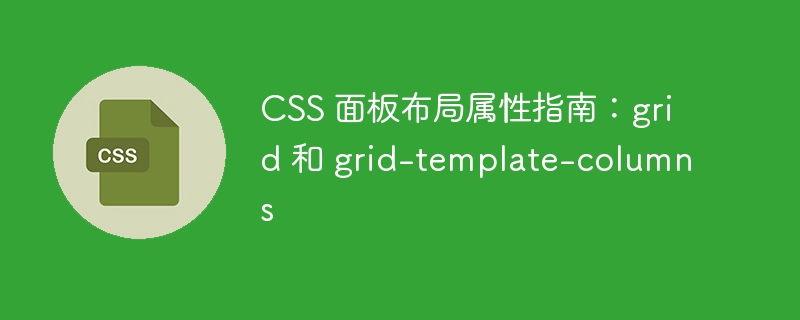

CSS panel layout property guide: grid and grid-template-columns
Introduction:
In modern web design, implementing complex layouts is a must Essential skills. The development of CSS has made it easier to create flexible and composable web page layouts. In this article, we will focus on the CSS grid property and the grid-template-columns property, which are powerful tools for implementing panel layouts.
What is grid layout?
Grid layout is a new layout model in CSS, which allows us to define and layout web content using a combination of rows and columns. By applying the grid attribute on the parent container, we can easily create web page layouts with flexible and responsive features.
What is the grid-template-columns property?
grid-template-columns is one of the important attributes of grid layout, which is used to define columns in grid layout. By specifying the width and number of columns, we can create panel layouts with different numbers and widths of columns. The value of this property can be a fixed pixel value, a percentage, or other units.
Sample code:
Let us use an example to demonstrate how to use the grid-template-columns attribute to implement a flexible panel layout. Consider the following sample layout:
<!DOCTYPE html>
<html>
<head>
<style>
.container {
display: grid;
grid-template-columns: repeat(3, 1fr);
gap: 10px;
}
.panel {
background-color: #ccc;
padding: 10px;
}
.panel:first-child {
grid-column: 1 / span 2;
}
.panel:nth-child(2) {
grid-column: 3;
grid-row: 1 / span 2;
}
</style>
</head>
<body>
<div class="container">
<div class="panel">面板1</div>
<div class="panel">面板2</div>
<div class="panel">面板3</div>
<div class="panel">面板4</div>
<div class="panel">面板5</div>
</div>
</body>
</html>In the above example, we turned the .container element into a grid container by setting the display attribute to grid. Next, we use the grid-template-columns property to divide the container into 3 columns, each with a width of 1fr. 1fr here means evenly allocating available space.
Next, we use the grid-column attribute to lay out specific panels. For example, the first panel spans columns 1 and 2, while the second panel takes up column 3 and the new first and second rows.
Finally, we use the gap attribute to add 10 pixels of space between panels to make the layout look more beautiful and clear.
Summary:
By using the grid and grid-template-columns properties, we can easily create flexible and responsive panel layouts. By specifying the number of columns and width, we can flexibly combine different grid layouts. I hope this article will help you use grid layout in web design, making your layout more flexible, beautiful and adaptable to devices with different screen sizes.
The above is the detailed content of CSS panel layout property guide: grid and grid-template-columns. For more information, please follow other related articles on the PHP Chinese website!




